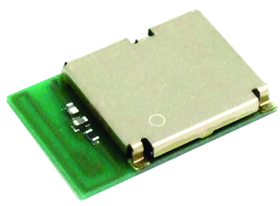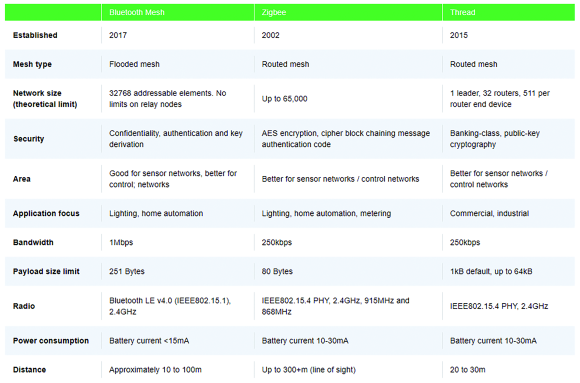

Recent advances in wireless technology have enabled the use of mesh network topologies in home and building control applications.
Low-cost IoT technology is driving the launch of devices such as smart lighting systems, smart locks, smart thermostats, voice control products, smart alarms, garage door openers, smart fan control, smart plugs and many more.
Wireless mesh networks (WMN) are an ideal solution for these types of applications, offering cable-free, low-power and low-cost methods of connecting multiple devices within an area, such as a large single-floor or multi-floor dwelling or office. The emergence of WMN protocols such as Zigbee, Thread and, more recently, Bluetooth, have further enhanced the appeal of WMNs, by simplifying the configuration and management of WMNs.
Wireless mesh networking
In a mesh topology the network nodes connect directly to as many other nodes as possible, cooperating with one another to route data across the network. This topology allows the creation of very large networks of interconnected, low-power devices and also has the advantage of being ‘self-healing’ due to the multiple possible paths that data can take through the mesh.
The exact functionality of the network nodes varies depending on the specific WMN protocol (as shown in Table 1, page 24) but a node can either function as a network routing element, receiving and transmitting data bound for another node, an end-point device, such as a sensor, or a combination of both. A WMN will also include at least one gateway device, enabling connectivity beyond the mesh, e.g. for Internet ‘backhaul’.
WMN protocols
Four main WMN protocols have emerged in recent years: Z-Wave, Zigbee, Thread (based on 6LoWPAN) and, most recently, Bluetooth mesh. Each protocol has its own characteristics, such as maximum network size, throughput and latency, but all four support the creation of low-power, low-data networks and are ideal for home and building automation applications.
Zigbee, the most established, has the largest ecosystem, including manufacturers such as Amazon Echo Plus, Philips Hue, Comcast Xfinity, IKEA and Samsung SmartThings. Thread’s legacy, based on its reputation for enhanced security levels, is in the industrial sector but, backed by Google (through Nest Labs), and with organisations such as Apple joining the ecosystem, the popularity of the protocol is set to grow.
As each protocol evolves, however, the performance differences between them are likely to decrease; Bluetooth mesh in particular is likely to quickly gain support due to the overwhelming number of manufacturers and devices using previous versions for classic point-to-point applications.
WMN application design considerations
One of the most important factors to be considered when choosing a protocol for an application is the ecosystem. Based on its maturity and popularity, Zigbee has the most devices using the protocol, with a large library of pre-developed software available.
Bluetooth’s ecosystem, on the other hand, is potentially huge, due to its ubiquitous use in smartphones, tablets, etc., and more and more Bluetooth mesh network applications are being developed. Bluetooth also has the benefit of being easier to scale for large networks.
Out of the three protocols, Thread is the only one based on IPv6, providing unique benefits, such as end-to-end routing and addressability on the same network or across networks, without the need for additional translation layers to be implemented.
Other factors to consider include maximum network size, throughputs and latencies. Comparative studies show that all three perform similarly in small networks under small payloads, with Bluetooth lagging the other two as payload and throughput needs increase. Whilst latency for all three protocols increases with network size, Bluetooth mesh latency increases the most.
A growing number of multi-protocol WMN modules is appearing on the market, which brings interoperability advantages and also enables network devices to combine functionality, such as the network-
ing characteristics of Zigbee with the beaconing and direct control functionality of Bluetooth.
Example wireless module
The Taiyo Yuden EYSKBNZWB is an example of such a multi-protocol device, capable of running the Bluetooth 5.0 and 802.15.4 stacks concurrently, supporting Bluetooth as well as Zigbee or Thread, and enabling interoperability between protocols.
By acting as a gateway, the EYSKBNZWB enables newer devices running Bluetooth to be added to existing networks based on Zigbee or Thread. This gateway functionality simplifies the extension or upgrading of existing home or building networks as new devices and applications can easily be added without having to replace existing networks.
The module also provides valuable end-user benefits by enabling smartphones to interact directly with network devices such as light bulbs, without the need for a multi-standard gateway. NFC is also
supported by the EYSKBNZWB, which offers further pairing options as well as supporting applications such as smart locks.
The module is based on the Nordic nRF52840 chip and, as Nordic is the market leader in Bluetooth, application developers have access to an extensive library of pre-developed software. Although small, the EYSKBNZWB is a full-spec Bluetooth 5.0 module with an onboard antenna and is unique in that it supports high data rates, up to 2 Mbps, and long range, with output power up to +8 dBm.
Summary
Three main WMN protocols have emerged as contenders for the smart home and building market, each with its own pros and cons, depending on the needs of the specific application. Multi-protocol modules such as the Taiyo Yuden EYSKBNZWB enable the developer to achieve interoperability and also combine features of more than one protocol on a single device.

For more information contact Avnet South Africa, +27 11 319 8600, [email protected]

© Technews Publishing (Pty) Ltd | All Rights Reserved